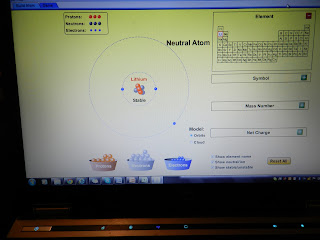Protons: 3
Neutrons: 3
Electrons: 3
Density: .53 g/cm
Protons: 5
Neutrons: 6
Electrons: 5
Density: 2.34 g/cm
· Density: the degree of compactedness of a subject
3. Run the Density simulation http://phet.colorado.edu/en/simulation/density and complete one(your choice) of the prepared Teaching Ideas and post your results on your blog. The activity you choose should be one of the student intended activities.
Floating and Sinking:
Pre Lab Questions:
Pre Lab Questions:
You have a block, and you see that it floats in water.
What could it be made of?
· Styrofoam
· Plastic
· Wood
· Ice
What do you think will happen if you make a bigger block out of the same material? Will it float or sink?
· The object will still float.
What could it be made of?
· Cement
· Aliminum
· Rock
· Brick
What do you think will happen if you make a smaller block out of the same material? Will it float or sink?
· The object will still sink.
Why do you think Block #1 floats and Block #2 sinks?
Block #1 and Block #2 are made from different materials and each of the materials has a different density. Any material with a density less than 1 will float on water. Anything with a density larger than 1 will sink in water.
Block A - Gold
· Mass: 65.14 kg
· Volume: 3.38
· Density: 19.27 kg/L
Block B- Apple
· Mass: .64 kg
· Volume: 1.00 L
· Density: .64 kg/L
Block C- Gasoline
· Mass: 4.08 kg
· Volume: 5.83L
· Density: .69 kg/L
Block D- Ice
· Mass: 3.10 kg
· Volume: 3.38 L
· Density: .92 kg/L
Block E- Diamond
· Mass: 3.53 kg
· Volume: 1.00 L
· Density: 3.53 kg/L
5. Identify and post on your blog the Science Standards that could be met through these activities completed in Activity 5
· A.4.1 When conducting science investigations, ask and answer questions that will help decide the general areas of science being addressed.
· C.4.3 Use multiple sources of information to help answer questions selected for classroom investigations.
· A.4.2 When faced with a science-related problem, decide what evidence, models, or explanations previously studied can be used to better understand what is happening now
· C.4.6 Communicate the results of their investigations in ways their audiences will understand by using charts, graphs, drawings, written descriptions, and various other means, to display their answers
· B.4.1 Use encyclopedias, source books, texts, computers, teachers, parents, other adults, journals, popular press, and various other sources, to help answer science-related questions and plan investigations



No comments:
Post a Comment